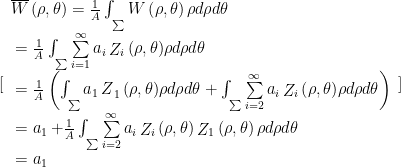1. Theory introduction:
Zernike polynomial [1] (Netherlands) physical scientistFrits Zernike )Is a polynomial sequence defined on the unit circle and satisfying orthogonality, which can be written as:

Among them, Is the j-th Zernike mode, 0 ≤ r ≤ 1, 0 ≤ θ ≤ 2 π, m and N are the angular series and radial series of polynomials respectively, and m ≤ n is satisfied; When n − | m | is even, and radial polynomial
Is the j-th Zernike mode, 0 ≤ r ≤ 1, 0 ≤ θ ≤ 2 π, m and N are the angular series and radial series of polynomials respectively, and m ≤ n is satisfied; When n − | m | is even, and radial polynomial Defined as:
Defined as:

2. Some properties of Zernike polynomials
2.1 Zernike polynomials are orthogonal, which can be written as follows:

2.2 the mean value of all orthogonal polynomials except the translation term (piston mode) is zero;
2.3 the mean value of each orthogonal polynomial (excluding piston mode) is 0; The proof is as follows (using property 2.1):

2.4 the mean wave front is equal to the coefficient of the translation term (piston mode)

2.5 each standard orthogonal polynomial has a minimum variance;
2.6 the wavefront variance is the sum of the squares of the coefficients of each polynomial, excluding the coefficients of the translation term;

Because of my limited ability, I can only do this.
So, is there a corresponding relationship between the j-th mode and n and M? The answer is yes. Generally, given any q, you can find the values of n and m. However, the values of n and m are related to the ranking of Zernike polynomials. The common ranking methods are Noll sequence (applied to atmospheric turbulence), OSA (human eye aberration) and Fringe. No matter how the ranking is, the value of Zernike polynomials is not required.
In addition, it should be noted that the polynomial is defined in the unit circle. In actual operation, a mask function needs to be added to shield the data outside the circle. Mainly, the data outside the circle is much larger than the data inside the circle.

3. Matlab simulation part:
3.1 define Noll sorting method
The values of j, m and n in Noll are as follows
about j = 1:20 j = [1, 2, 3, 4, 5, 6, 7, 8, 9,10,11,12,13,14,15,16,17,18,19,20] NOLL Lower n and m The value of is: m = [0, 1,-1, 0,-2, 2,-1, 1,-3, 3, 0, 2,-2, 4,-4, 1,-1, 3,-3, 5] n = [0, 1, 1, 2, 2, 2, 3, 3, 3, 3, 4, 4, 4, 4, 4, 5, 5, 5, 5, 5] and OSA The following values are: m = [0,-1, 1,-2, 0, 2,-3,-1, 1, 3,-4,-2, 0, 2, 4,-5,-3,-1, 1, 3] n = [0, 1, 1, 2, 2, 2, 3, 3, 3, 3, 4, 4, 4, 4, 4, 5, 5, 5, 5, 5]
Use code to realize Noll sorting, and return the values of n and m according to the sequence number j of Zernike polynomial:
function [n,m] = Noll_to_Zernike(j)
% Serial number j Start with 1; j = 1 For piston pattern
if(j<1)
error('Noll indices start at 1.');
end
n = 0;
m = 0;
j1 = j-1;
while (j1 > n)
n = n + 1;
j1 = j1 - n;
m = (-1)^j * (mod(n,2) + 2*floor((j1+mod(n+1,2))/2));
end
endOSA sorting is realized by code, and the values of n and m are returned according to the sequence number j of Zernike polynomial
function [n,m] = OSA_to_Zernike(j)
% Pay attention here j Starting from 0, j = 0 Corresponding to piston pattern,
% If you want to start from, the parameters passed in are j-1,At this time, you can communicate with Noll_to_Zernike matching
n = floor(sqrt(2*j+1)+0.5)-1;
m = 2*j-n*(n+2);
end3.2 main part of Zernike polynomial
function Znm= Zernike(j,res)
% parameter j: Zernike Sequence number of polynomials
% parameter res: Zernike Polynomial resolution
x = linspace(-1,1,res);
[x,y] = meshgrid(x,x);
[theta,rho] = cart2pol(x,y);% from(x,y)conversion(r,theta)
[n,m] = Noll_to_Zernike(j); % Call function, return n and m Value of
% [n,m] = OSA_to_Zernike(j-1)
if m == 0
deltam = 1;
else
deltam = 0;
end
Norm = sqrt(2*(n+1)/(1+deltam));% Normalization factor
Rnm_rho = zeros(size(rho)); % Initialize radial polynomial
for s = 0:(n-abs(m))/2
Rnm_rho = Rnm_rho+(-1)^s.*prod(1:(n-s))*rho.^(n-2*s)/(prod(1:s)*...
prod(1:((n+abs(m))/2-s))*prod(1:((n-abs(m))/2-s))); % Radial polynomial
end
if m < 0
Znm = -Norm.*Rnm_rho.*sin(m.*theta); % m<0 Time zernike polynomial
else
Znm = Norm.*Rnm_rho.*cos(m.*theta); % m>0 Time zernike polynomial
end
Znm = Znm.*(rho<=1); % mask = (rho<=1),Only the data within the unit circle is retained
end3.3 main function
clc;clear all; close all
% Generate a pattern separately
res = 60; % The resolution is set to 60
Z = Zernike(3,res); % 3rd mode (astigmatism)
figure(1);imagesc(Z);colormap(jet);colorbar
% The first 60 modes are generated with a resolution of 60
num = 60;
Znm = zeros(res,res,num);
for i= 1:num
Znm(:,:,i) = Zernike(i,60);
end
figure(5);imagesc(Znm(:,:,5));colormap(jet);colorbar3.4 results section
After running the code, the image will appear.